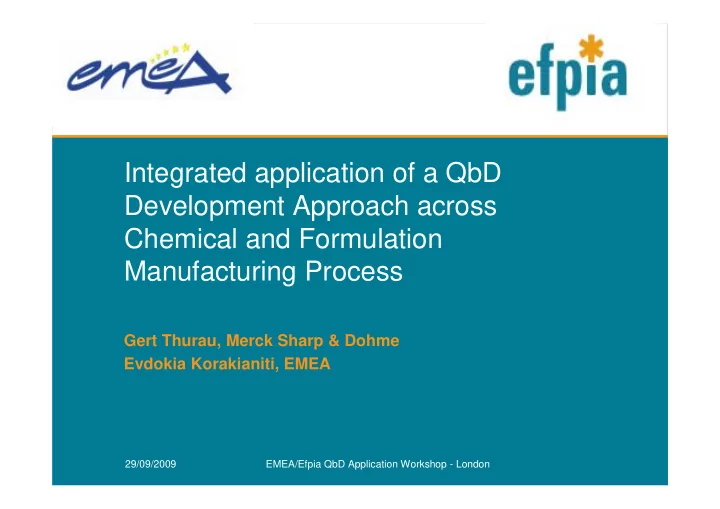

Integrated application of a QbD Development Approach across Chemical and Formulation Manufacturing Process Gert Thurau, Merck Sharp & Dohme Evdokia Korakianiti, EMEA 29/09/2009 EMEA/Efpia QbD Application Workshop - London
Case Study Case Study Summary Drug Substance Process Development • Use of DOE in individual process steps yield different results, resulting in different types of correlations – Predictive models covering total ‘knowledge space’ – Simpler statistical correlations covering only DOE space • Use of standard processing platforms allows effective scale-up – From pilot scale (90kg) to production scale (several hundred kg) with good predictability • Good understanding of factors controlling psd – Assures key factor for drug product process is in control 2 29/09/2009 EMEA/Efpia QbD Application Workshop - London
Case Study Case Study Summary Drug Product Process Development • Risk assessment led to use of large DOE at pilot scale – Full scale experiments to confirm DOE results but not to fully re-establish design space • Significant use of PAT during development, technology transfer and in commercial process • Particular focus on understanding of dissolution behavior vs. Bioavailability – Detailed analysis of dissolution steps – Disintegration rate predicts dissolution measurements 3 29/09/2009 EMEA/Efpia QbD Application Workshop - London
Case Study Case Study Summary Control Strategy Drug Substance • Control strategy uses conventional approaches • Control of attribute particle size distribution is linked to drug product design space Drug Product • Control strategy is using processing parameters as “knobs” but monitors material attributes as output • Real-time release testing strategy 4 29/09/2009 EMEA/Efpia QbD Application Workshop - London
Main Topics Discussed • Risk Assessment – A summary of the potentially relevant process parameters based on previous knowledge can be presented in a fishbone diagram. – Based on this fishbone diagram, each variable can be assessed in detail by a FMEA procedure and a Risk Priority Number (RPN) number is assigned. (RPN= impact (I) x probability (P) x detectability (D)). – It is recommended to include an explanation of how the scoring has been performed – It is recommeded to include a justification for the selection of variables for further study. 5 29/09/2009 EMEA/Efpia QbD Application Workshop - London
Common Understanding • Design Space – DOE useful tool in development of a DS but not the only one • 1 st Principles models – DS may cover one, or multiple unit operation(needs to be clear in the dossier) • Not all unit operations must have a DS • Unit operations without a DS will obviously not achieve the regulatory benefits (ie, ability to move within DS) 6 29/09/2009 EMEA/Efpia QbD Application Workshop - London
Common Understanding • DS scale up – DS is usually developed at lab scale – There is no need to perform full DOEs at full scale to confirm the DS at full scale. – Good understanding of scale up phenomena is needed, some parameters may be scale independent (needs to be justified) – Scale up factors could be used to reduce concern about moving within DS at scale • Experiments within the DS at full scale could also be used to reduce the same concern. • Another option is have additional monitoring controls applied when there is a change within the DS to ensure that the DS is still valid and then relaxation to a less stringent control strategy. 7 29/09/2009 EMEA/Efpia QbD Application Workshop - London
Common Understanding • DS needs to be complemented by an appropriate control strategy • Critical process parameters remain critical even if controlled, • CQAs: appropriate specs need to be set, even if not tested routinely • Release based on CQAs and control of process parameters is possible if satisfactorily demonstrated ( e.g. dissolution release based on particle size control, and disintegration test) 8 29/09/2009 EMEA/Efpia QbD Application Workshop - London
Areas For Further Work • Level of risk assessment detail in the submission • Description of non-critical parameters and impact on post approval changes – included in DS? • not described at all in submission • ranges established, but not part of design space? • DS changes post approval – Changes to an approved DS are subject to the variations regulation in force at the time of the application – Post approval change management plans subject to discussion at the moment; outcome still to be seen – DS is not set in stone • DS is expected to change / improve as experience is gathered – How to achieve this is subject for future discussion 9 29/09/2009 EMEA/Efpia QbD Application Workshop - London
Areas For Further Work • Acceptance criteria for large sample sizes ( EDQM ongoing work) • Draft NIR guidance • And much more…. 10 29/09/2009 EMEA/Efpia QbD Application Workshop - London
Recommend
More recommend